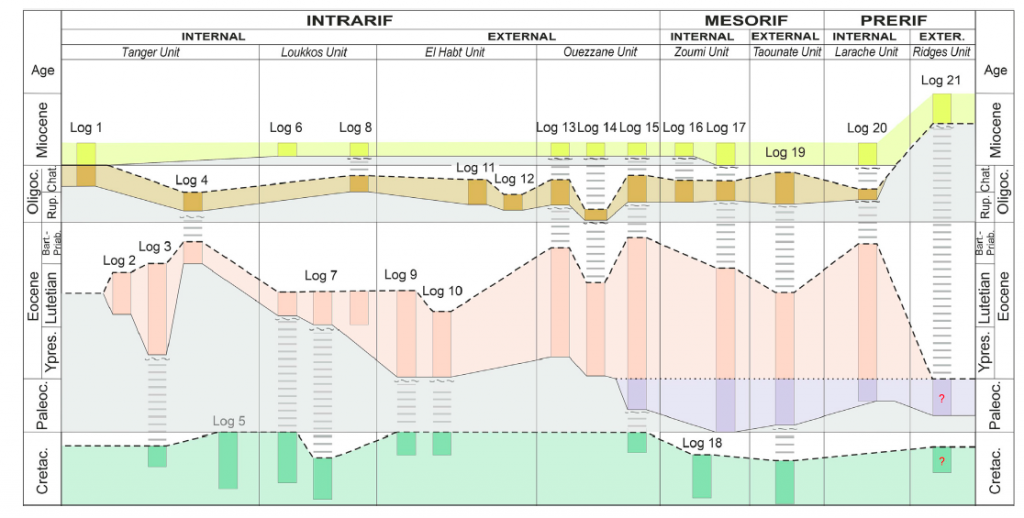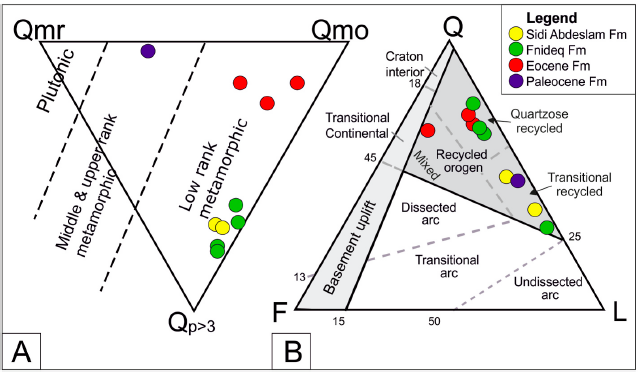Home » Rif
Category Archives: Rif
Paleogene evolution of the External Rif Zone (Morocco) and comparison with other western Tethyan margins
The Paleogene evolution of the NW margin of the African Plate (Western External Rif Zone) was studied by means of multidisciplinary analyses of twenty-one stratigraphic logs, including tectofacies recognition, petro-mineralogical results, and thicknesses analysis. Four stratigraphic intervals were recognized separated by three unconformities coarsely aligned with the Cretaceous–Paleogene, Eocene–Oligocene and Oligocene–Miocene boundaries, respectively. Tectofacies appear from the late Ypresian being more frequents from the Oligocene as the tectonic activity increases. The petrology of detrital suites indicates recycled orogen-derived sediments, with quartz supplied from metamorphic rocks of the Atlas orogen and/or the African craton. On the basis of Mesozoic claymineral assemblages reported in the literature, the clay mineralogy of mudstones suggests upper Jurassic to upper Cretaceous terrains from the Internal Intrarif as the main source area of the Paleocene–Eocene successions, with sediment provenance reversion during the Oligocene and additional contribution of Paleocene to lower Eocene suites. The different displacement capability of the identified aluminic-magnesic claymineralogy enabled to deduce the relative proximity of the source area. These findings point out a complex sedimentary evolution characterized by a mixture of different lithotypes dating back to upper Jurassic. X-ray parameters helped to identify evidences of synsedimentary tectonics overprinting the inheritedmineralogy during some periods with weak burial diagenesis at most.

During the Paleogene a foreland basin is formed mainly in theMesorif and Prerif sub-domains. This foredeep was represented by two ‘sub-geosynclines’ separated by a relative bulge located in the External Mesorif. The Internal Intrarif could represent the relative orogenic front, advancing on the External Intrarif. The Eocene forebulge was located in the Ridges Domain, while the Gharb Basin was the backbulge of the system. During the Oligocene the depocentral area migrated southward and a homogeneization of thicknesses took also place in the whole margin. In this new configuration, the foredeep would be located in the External Mesorif (previously a relative bulge) while the Ridges Domain and the Gharb Basin continued to act as the system forebulge and backbulge, respectively. A comparison with the Paleogene evolution of other western Tethys external margins (Betic Chain, Tunisian Tell, Sicilian Maghrebids, and Apennines) has revealed more similarities than differences. The effects of the Eo-Alpine tectonics are recognized everywhere even if they decrease both from N to S, and from W to E in the different considered margins. The evolution of the compared margins shows a common pre-foredeed (Paleocene-Eocene) and beginning of foredeep (Oligocene) stages in the foreland basins.
Cite as: Martín-Martín, M., Guerrera F., Cañaveras, J. C., Alcalá F. J., Serrano, F., Maaté, A., Hlila, R., Maaté, S., Tramontana, M., Sánchez-Navas, A., and Le Breton, E. (2023). Paleogene evolution of the External Rif Zone (Morocco) and comparison with other western Tethyan margins. Sedimentary Geology, 448, 106367. doi: 10.1016/j.sedgeo.2023.106367
Provenance and paleogeographic implications for the Cenozoic sedimentary cover of the Ghomaride Complex (Internal Rif Belt), Morocco
The Cenozoic sedimentary cover from the Ghomaride Complex (Internal Rif Belt) has been studied in the Tetuan area (N Morocco) where a suite of sedimentary successions from shallow-marine to deep-marine environments crops out. For that purpose stratigraphic relations and petrological and geochemical signatures have been analyzed. Sandstone suites of the overall succession are heterogeneous and testify a multi-source area, in response of accretionary processes of the Ghomaride-Malaguide units and the exhumation of the lower units of the Internal Rif Zone (e.g. Sebtide-Alpujarride Complex). Pre-orogenic and Syn-orogenic (according to the eoalpine phase) deposits have been identified consisting in two depositional sequences: lower Paleocene and Cuisian-Bartonian, and upper Oligocene-upper Aquitanian and lower Burdigalian, respectively. Pre-orogenic deposits are mainly intra-arenite and hybrid arenites made of a minor amount of siliciclastic detritus but with abundance of intrabasinal carbonate grains. The syn-orogenic sandstone suites are quartzolithic, having abundance of low-grade metamorphic and sedimentary lithic fragments. Sedimentary lithic fragments are derived from the Mesozoic successions of the Ghomaride-Malaguide Complex while metamorphic detritus is related to an unknow Internal Rif Zone basement that was exhumed starting from the late Oligocene and mainly early Miocene. Modal analyses of sandstone suites for the extrabasinal grains mainly indicate lower rank metamorphic and sedimentary source terranes of a recycled orogen. Major and trace elements coupled to the mineralogical composition of the mudrock samples indicate a provenance from felsic source area(s) with a minor but not negligible contribution from mafic rocks mainly in the syn-orogenic suites.

Geochemical analyses (Al–Ti–Zr ternary plot) indicate minor reworking and recycling processes before the final deposition through prolonged processes of sedimentary transportation. The trends evident in both CIA and CIA’ diagrams indicate source areas characterized by moderate weathering in non-steady-state conditions with a weak change of weathering condition from the pre-orogenic to the syn-orogenic cycle. Deposition during the Paleocene and Eocene, took place in the southern continental margin of the Ghomaride-Malaguide domain as a carbonate ramp. Contrarily, sedimentation in the late Oligocene-late Aquitanian took place in wedge-top basins within the Ghomaride- Malaguide domain. These changes occurred during the Burdigalian, when back arc basins were developed in the Internal Betic-Rif Zone. The Cenozoic reconstructed record was contemporaneous of the structuring of the Circum-Mediterranean chains and the Ghomaride-Malaguide Complex played a key role in the geodynamic evolution of the Rif Cordillera, representing a key tectonic element of the western Mesomediterranean domains.
Recent Comments